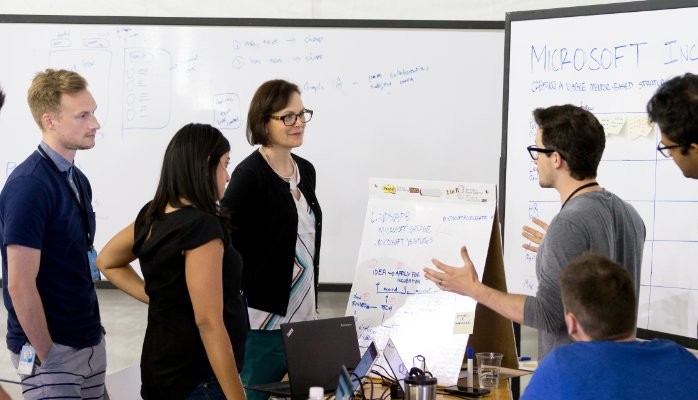
Screen In to diversify your workforce
Anyone who has ever interviewed at a tech company probably has an “interview story,” and I’m no different. Fresh out of business school, one of my first interview experiences was . . . well . . . memorable. Let’s just say we talked ad nauseam about the various uses of porcine parts. And while I grew up in Wisconsin and had some practical knowledge on the topic, I left wondering what the interviewer could have possibly gleaned from our discussion.
It didn’t matter; it wasn’t meant to be.
Over the years and through many more interview situations, I’ve reflected on that meeting and the lasting impact it had on me. Today, as Chief People Officer at Microsoft, I’m ultimately accountable for 110,000+ employees around the globe—including their interview experience, which is often their first exposure to our company and sets the tone for our potential relationship.
Microsoft’s interview approach has evolved with our culture, and today is directly influenced by our mission of creating products and services that empower everyone on the planet. With a mission that broad, we need to appeal to everyone, and that means bringing in the widest variety of perspectives to represent the diverse audiences we serve.
Naturally, the question that arises from this approach is: how do you cast a net that wide, yet retain a high bar of excellence?
We believe it’s about Screening In versus Screening Out, and it’s a method we’re putting into practice across our entire recruiting and interviewing processes.
Screening In
At its core, Screening In reflects our desire to bring in talented people who aren’t carbon copies of existing employees, because building a homogenous workforce isn’t the best way to innovate and problem solve for the increasingly diverse customers we serve.
The idea is to find common ground with candidates, instead of ways of ruling them out. We want to make the interview process more tailored to the individual, and have interviewers approach candidates with a mindset of, “How can I help them be successful here?” and, “What skills and experiences do they have that we need?” and “Do they share our passion for our company’s mission?” The intent is not to trip candidates up or find what’s wrong, but rather find what’s right and determine if we can succeed together.
Implementing a Screening In approach
Change can be hard, especially in companies with a long history of doing certain things certain ways. But any organization can work to implement a Screening In approach. I think it starts with three key drivers:
- Create job descriptions that reflect the role. Employment is just like any other relationship: It takes a 50/50 effort on each party’s side to ensure long-term success. This starts with a job description that describes the actual role. Take a close look at your job descriptions and make sure they explain the experiences individuals will get in that role. Cast aside the jargon, and replace it with language that embraces diversity and inclusion principles. Then talk about the role in simple words that are meaningful, accurate, and enticing to potential employees.
- Invest in inclusive hiring tools. Teach interviewers to recognize and acknowledge candidates’ needs and style differences and how to offer candidates choices during an interview. While “white boarding” may work for one candidate, using a laptop or a paper and pencil may work for another. A little training on interviewing skills and inclusivity goes a long way, so invest in workshops or on-demand videos that use role-playing examples.
- Diverse experiences create a diverse workforce. Rather than hiring exclusively from a specific pool of candidates, look for people who bring something unique. We’ve found incredible talent through our autism and disability hiring programs, and the same goes for our military recruitment programs. Start with pilot programs to ensure you’re creating successful onboarding and inclusivity, and then consider ways to expand your programs to embrace more diverse talent. (Read more about our autism program in Fast Company.)
Let’s be clear that skills, talent, and passion for our mission are still drivers for landing a job at Microsoft, and they always will be. But rethinking our interviewing approach to be more inclusive and using a Screening In method has helped us expand our talent pool to better serve our customers and employees. I encourage you to consider what your organization is doing to Screen In, and please share your ideas with me on how your company is adopting this approach.
Principal Cloud Solution Architect
2yRight on! Interviewing a candidate to determine what they bring to the table to add to your team and company is much more effective as opposed to interviewing to exclude! Could not agree more!
VP, Talent Acquisition & Mobility @ General Dynamics | Talent Acquisition Expert
3ySo I just saw this article on LinkedIn, but it was written 4 years ago. Black representation at MSFT in October 2020 was 4.9%. 2.9% of Exec and Partner-level positions. Hmmmm.
Senior HRBP Professional
4yKathleen Hogan- Very well articulated! Driving creativity , Innovation every single day to meet diverse customer needs would not be possible with homogeneous workforce. This 'Screening In' process can disrupt the approach of driving consistency through legacy and will breed fresh perspectives in teams across industries!
Principal Corporate Consultant // HR Solutions // HR Business Partner //
6yI wonder how diversity could increase if we use algorithm and artificial intelligence for cv and pre interview screening. How do you see the use or set up of this technology for the first screening of candidates?
Connecting people to drive collaboration and employee engagement
6yThank you for sharing and bringing greater attention to the changing relationship between employers and candidates. I wanted to share the journey my company DBS Bank, an Asian bank with a strong digital focus and agenda to reimagine banking. This agenda extends to reimagining the interview experience and screen in approach to ensure we bring in people who can be successful with us.